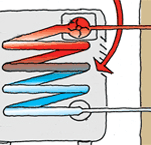Energy
Designing homes to conserve energy and use it efficiently, from sources that cause least environmental harm.
Heat pumps
Heat pumps can be an extremely energy-efficient form of space heating and cooling – provided they are sized, installed, and used properly.
On this page:
- Advantages and disadvantages of heat pumps
- How heat pumps work
- Heat pump energy sources
- Energy efficiency of heat pumps for space heating
- Heat pump capacity
- Heat pump size
Also see heat pump configuration and installation.
Air-to-air heat pumps, the most common type in New Zealand, use refrigerant to absorb heat from one space and transfer it to another via a heat exchanger (often a fin or coil). The electricity supply to a heat pump is only used to move the heat around, not to generate it – the heating itself has a passive energy source.
Heat pumps are popular in New Zealand because of their high efficiency and ‘clean’ energy image. Most are installed to provide heating, although it is becoming more common for them to also be used for summer cooling. Some local authorities offer incentives to switch to heat pumps from less efficient, more polluting technologies.
Advantages and disadvantages of heat pumps
Advantages of an air-to-air heat pump include:
- it is very efficient at converting energy to heat (optimum efficiency is when the difference between source and supply temperatures is very small)
- lower cost per unit of heat (kWh) compared to most other space heating options
- it provides a medium to fast source of heat
- it has the ability to provide heating and cooling
- many have timer controls programmable for 7 days and some connect to home WiFi to allow remote control via smartphone.
Drawbacks of air-to-air heat pumps are:
- regular maintenance is required (cleaning the filter on the indoor unit) and a service check every 2–3 years
- loss of efficiency as temperature decreases below 6–7ºC (but some models can still provide heating in temperatures down to -15ºC)
- higher initial purchase and installation cost than portable heaters
- air distribution is by fan, which can cause draughts and some noise
- space is needed to install the exterior unit
- penetrations have to be made through the weatherskin of the building
- no heating during a power cut.
Although heat pumps are an efficient form of heating, installing a heat pump is not likely to reduce heating costs. In a BRANZ study of 160 households with heat pumps, more people said their energy costs had increased since acquiring a heat pump than those who said their energy costs had fallen. Only 15% described running costs as excellent. Occupants keep their homes warmer than previously.
Heat pumps do not replace the need for good insulation. In that same BRANZ study (covered in BRANZ Study Report 329), half the households that achieved less than 18°C average winter evening temperatures had no or poor insulation.
How heat pumps work
Heat pumps operate on very similar principle to a fridge. Refrigerant flows through connected indoor and outdoor coils. In heating mode, as the liquid refrigerant flows to the outdoor coil, it passes through an expansion valve that creates rapid expansion of the liquid, causing it to become a gas. This results in very rapid cooling of the refrigerant. Then as it flows through the outdoor coil, it is able to absorb heat energy from the air. Before it flows through the indoor coil, it passes through a compressor where the gas is compressed, increasing both the pressure and the temperature. As it moves through the indoor coils, the gas condenses, releasing latent heat.

- Heat pump
Schematic diagram of how a heat pump operates in heating mode.
Heat pump energy sources
Most heat pumps in New Zealand are air-to-air units. The heat source is plentiful, but can be variable, which can affect efficiency. As temperatures fall, air-to-air heat pumps can require defrosting and then are not providing heat. This makes them less effective in areas with extremely cold winters (particularly if the humidity is also high).
There are two other sources of energy used for heat pumps:
- Ground-to-air heat pumps have the advantage of fairly constant sub-soil temperatures year-round, typically averaging 12–15°C at around 1–1.5 metre depth. They therefore have fairly high efficiencies even on very cold winter nights. They are considerably more expensive to install, however. Most parts of New Zealand do not have the climate extremes or heating demands to justify the cost.
- Water-to-air heat pumps – water is also an excellent source of low grade heat but is only suitable where buildings are located close to a water supply.
Energy efficiency of heat pumps for space heating
As heat pumps only move heat and do not actually generate it, they have a very high ratio of heat output to energy input. This heating energy efficiency is expressed as a coefficient of performance (COP), while cooling energy efficiency is expressed as an energy efficiency ratio (EER).
Typical domestic heat pumps have a COP of 2–4.5, which means the heat pump produces about 2–4.5 times as much heat as the electricity it uses (under optimum conditions). Some heat pumps have COP’s as high as 5.7. The efficiency of an air-to-air heat pump decreases as the temperature difference between source and supply increases – as outside temperatures drop, the heat pump’s energy efficiency reduces.
Heat pumps are currently the only form of heating, aside from solar, where the COP is (usually) greater than 1, which makes them the most efficient form of purchased space heating commonly available.
The cooling energy efficiency ratio (EER) is typically about 2.5–4.0, which means the heat pump produces about 2.5–4 times as much cooling power as the electricity it uses. Some heat pumps have EER’s as high as 5.8.
When selecting a heat pump, consider its primary use. If it will mostly be used for heating, select for a high COP; if mostly used for cooling, select for a high EER.
Under the Energy Efficiency (Energy Using Products) Regulations 2002, heat pumps for sale in New Zealand must meet the Minimum Energy Performance Standard (MEPS) given in AS/NZS 3823.2:2013 Performance of electrical appliances - Air conditioners and heat pumps – Part 2: Energy labelling and minimum energy performance standards (MEPS) requirements.
An Energy Rating Label must be displayed on all new heat pumps for sale. The label shows a star rating – the more stars (out of a possible 10), the more energy efficient the heat pump is. More efficient models have lower running costs.
New zoned energy rating labels give a star rating (out of a possible 10 stars) for the heating performance of a heat pump. The more red stars, the more efficient a heat pump will be at heating when compared to other models of the same size. Another great tool for comparing different models is the Efficient Appliance Calculator on the GenLess website.
Heat pump capacity
The heating capacity of an air-to-air heat pump (in the heating cycle) is typically between 2–16 kW for domestic systems. The cooling capacity (in the cooling cycle) is generally about 10–20% less than heating capacity.
To reflect a variation in capacity depending on outside temperatures, heat pumps can have three heat capacity ratings. These are based on standardised testing under laboratory conditions.
- H1 rates the unit’s heating output when the outside temperature is 7°C.
- H2 rates the heating output at 2°C ambient temperature.
- H3 rates the heating output at -7°C ambient temperature.
These ratings allow you to select the appropriate heat pump for the climate and household requirements (i.e. the design temperature and heating load) of individual situations.
It is important to note the advertised COP values are based on lab tests – in practice, the overall efficiency of a heat pump is likely to be lower, e.g. one rated as COP of 2.0–4.5 may have an actual overall operating efficiency of around COP 1.5–3.0.
Heat pump size
Getting sizing right for heat pumps is crucial for maintaining their efficiency.
If the heat pump is too big for the space requiring heating (or cooling):
- fixed speed systems will cycle on and off repeatedly (as the target temperature will be reached very quickly), which is inefficient and reduces the life expectancy of the unit
- ducted systems will have higher than necessary pressure, which can cause duct leakage.
If the heat pump is too small, the unit will run continuously as it attempts to reach the set point, which reduces the outside coil temperature and cause it to defrost regularly.
A general recommendation is to avoid using extremes of annual temperatures when selecting the ambient design condition and also to avoid exaggerating the set points for indoor heating and cooling.
Heat pump sizing calculations must take into consideration:
- region, location and orientation of the building
- specific local conditions
- orientation of windows
- seasonal high and low ambient temperatures
- levels of insulation
- number and types of occupants and their levels of activity
- solar gain.
A rough rule of thumb to determine the heating requirements for rooms is for:
- Older uninsulated houses – use 65 W/m3 room volume
- Newer well-insulated houses – use 50–55 W/m3 room volume.
Ducted heat pump systems require careful design. They can have heating energy loss of more than 30% if the ducts are overlong and/or have many bends, or travel through uninsulated space such as attics. The majority of heat pump systems do not include a fresh-air supply system – they only recirculate room air. Ventilation requirements need to be managed by other means.
More information
Updated: 01 February 2022

